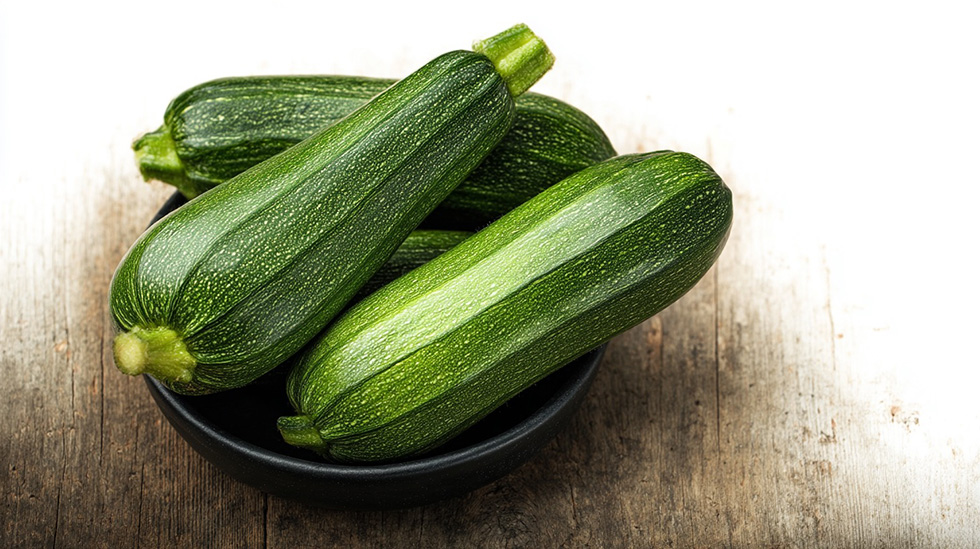The hassle-free all-rounder
You know that vegetable that goes with everything but isn’t intrusive? Tasty, light, healthy and even diet-friendly? Yes, it’s zucchini! But don’t be fooled by its simple appearance – there’s a lot more to courgettes than first meets the eye. Let’s take a closer look together to see why! 🥒

Zucchini is known by different names in different languages around the world: in English as “zucchini” (the American version) or “courgette” (the British version), but here we’ll stick to “zucchini”. Its scientific name is Cucurbita pepo, and it belongs to the pumpkin family, like cucumbers, pumpkins and asparagus.
It originated in Central America, but is now cultivated worldwide. It arrived in Europe in the 16th century and has since conquered the continent’s cuisines. It has become particularly popular in the Mediterranean.
Its importance in the kitchen
Rating: 4 / 5
Zucchini is still a relatively new vegetable in Hungarian cuisine, but it has long been a staple vegetable in European, especially Mediterranean, cuisine. I gave it a 4 because it’s very versatile, you can grill it, boil it, bake it, stir-fry it, and even put it in cakes. The only reason I didn’t give it an A is that it hasn’t yet become a staple food in every Hungarian household.
Which part is edible?
The edible part of the zucchini is the fruit itself – and the best part is the unripe part. Look for the tender, tender-skinned, seedless specimens, which are the tastiest. The flowers are also edible, and are a delicacy in Mediterranean cuisines, often stuffed or baked in a bundt pan.
The leaves and stems should not be eaten raw, as they may contain mildly toxic substances called kukurbitacins, which can cause a bitter taste and stomach upset. Overripe specimens may also contain these substances – so always choose the tender ones!
Health benefits
- It has a high water content, so it is very hydrating.
- It’s low in calories, so it’s a great diet food.
- An excellent source of fibre, which aids digestion.
- It is rich in vitamins A, C and B, as well as potassium and magnesium.
- It is anti-inflammatory and good for the heart.
According to traditional medicine, zucchini can help regulate blood sugar levels, relieve stomach problems and water retention.
Growing characteristics
The zucchini season in Hungary lasts from May to the end of September. This is when you are most likely to find local produce in the shops. In spring and late autumn, however, they are typically imported from Spain, Italy or Turkey.
It is grown both in the open field and in a greenhouse. In Europe, Spain produces the most zucchinis, followed by Italy and France. In Hungary, zucchini is mainly grown in the lowlands and the southern Transdanubian region.
How to choose good quality zucchinis?
- It should be firm, smooth-skinned and brightly coloured – different shades of green are fine.
- Avoid soft, pressed, wilted specimens!
- The smaller (15-20 cm) courgettes are tastier, more tender and the seeds are not bothersome.
- It should be firm to the touch, but not too hard.
How to store it at home?
Zucchini is sensitive to cold, so don’t put it in the coldest freezer compartment! It’s best to store it in a perforated bag in the vegetable drawer, where the temperature is 4-8°C. This will keep them fresh for up to a week. If you slice it, then foil it and use it within 1-2 days!
In the kitchens of the world
- In Italy it is added to pasta, pizza, risotto and minestrone.
- In France, it plays a starring role in a vegetable stew called ratatouille.
- In Greece, they are stuffed, baked or stuffed and fried in oil.
- In India it is used for spicy curries.
- In America, they also make zucchini bread and muffins!
An iconic recipe: ratatouille
A French classic, ratatouille is a colourful vegetable ragout in which zucchini is perfectly juxtaposed with aubergine, peppers, onions and tomatoes. Seasoned with olive oil, garlic and Provençal spices, it is a true Mediterranean delight.
Tips for use in the kitchen
- Sliced or spiralized, they are delicious grilled or pan fried.
- Grated, you can also put it in sponge cakes or muffins – the kids will love it!
- It is also excellent diced in lecsó, casseroles and vegetable soups.
- It’s also worth filling: with a little minced meat, rice and cheese, it’s heavenly.
What spices go with it?
- basil
- oregano
- thyme
- garlic
- lemon juice or zest
Which ones should you avoid?
Very dominant spices, such as cinnamon or aniseed, don’t really go well with it, unless it’s used in a sweet cake, but even then, be careful!
Summary
Zucchinis are one of our most versatile, healthiest and best-loved vegetables – a real chameleon in the kitchen. If you haven’t been giving it enough attention, now is the time to change that. Buy it, cook it, bake it, grill it – and enjoy! 😉
